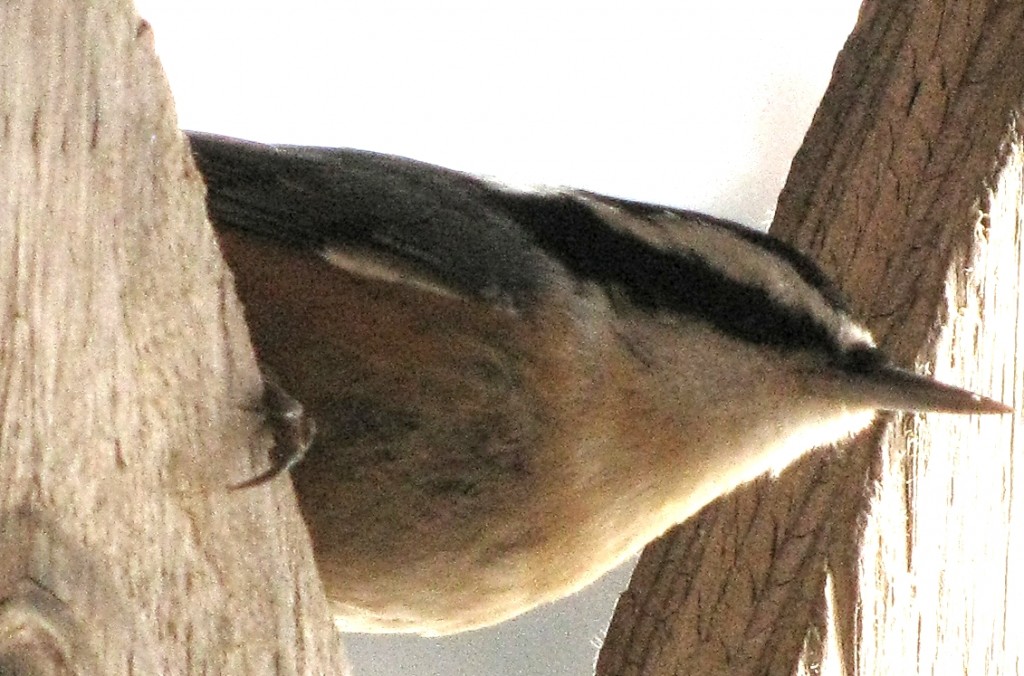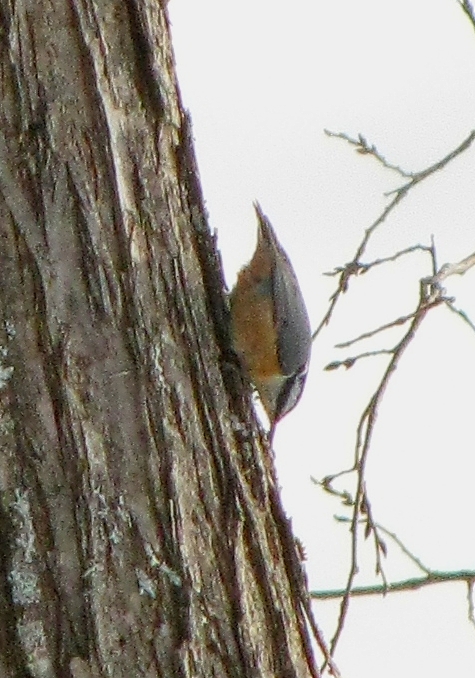
Red-breasted Nuthatch (© Magi Nams)
A new visitor has appeared at my feeder during the past week – a sharp-beaked, red-breasted nuthatch with a body shaped like two stout cones placed base to base. This nuthatch, with its rufous-tinted sides and belly and prominent white eyebrow above a narrow, black mask, is one of four North American nuthatch species belonging to the avian family Sittidae.

Red-breasted Nuthatch Foraging on American Elm (© Magi Nams)
Short-tailed, agile, and possessing a backward-facing toe with a huge claw that acts like a grappling hook, nuthatches are climbers extraordinaire, circling, ascending, and in particular, descending tree trunks and branches with ease. With their thin, sharp, tapered beaks, they pry up bark bits in search of insects and feed on conifer seeds. Their name is derived from their habit of lodging nuts in bark fissures and hammering them with their beaks until the hard-coated seeds break open and expose their nutritious contents.1
Of the four North American nuthatches – white-breasted, red-breasted, brown-headed, and pygmy – the red-breasted nuthatch, Sitta canadensis, has the most widespread geographical distribution, occurring year-round in coniferous and mixedwood forests from southern Alaska eastward to Newfoundland and Labrador, and wintering as far south as the Mexican border. The white-breasted nuthatch, the largest of the four species, inhabits deciduous and mixed woodlands (pines in the west) and ranges from southern Canada through America and well south into Mexico. The brown-headed nuthatch, which is similar in size to the red-breasted nuthatch, inhabits pine woodlands in southeastern America, while the pygmy nuthatch, the smallest of the four North American sittids, occurs only in yellow pine or Califonian pine forests in southern British Columbia and western America and Mexico.2
Although red-breasts are the nuthatches I most commonly see in northern Nova Scotia, I occasionally encounter white-breasted nuthatches as well. Both possess distinctive voices, the white-breasts calling out ‘yank, yank’ in a nasal tone that would be the envy of some country and western singers, and the red-breasts emitting a higher-pitched, nasal ‘meep, meep.’ These vocalizations are dead giveaways in dense vegetation.
Like chickadees, with whom nuthatches frequently travel (some also form mixed flocks with kinglets, brown creepers, woodpeckers, titmice, or warblers), nuthatches are cavity nesters, excavating nests in tree trunks or posts or using abandoned woodpecker holes or natural cavities. Interestingly, pygmy nuthatches form long-term pair-bonds and utilize the help of unmated male offspring or siblings to raise their broods.3 I’ve observed pairs of red-breasted nuthatches foraging in the mixed woods on our property, and on one occasion while gardening, watched a family group frenetically foraging upside-down in a stand of paper birch and white spruce, the rapid-fire cadence of their light, nasal voices a staccato summer song.
References:
1. W. Earl Godfrey. The Birds of Canada. 1979. National Museum of Natural Sciences, Ottawa, p. 281.
2. National Geographic. Field Guide to the Birds of North America. 1987. National Geographic, Washington, p. 332.
3. Paul R. Ehrlich, David S. Dobkin, and Darryl Wheye. The Birder’s Handbook: A Field Guide to the Natural History of North American Birds. 1988. Simon and Schuster Inc., New York, pp. 434-438.


